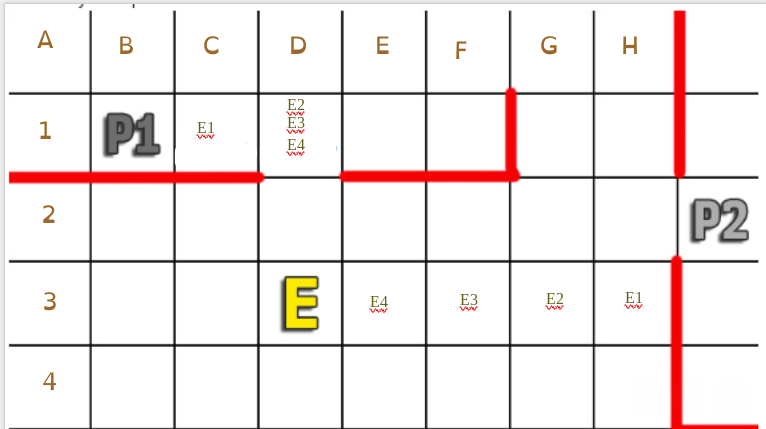The game designer (thank you Emil) and I devised this simple chart to explain how an Enemy moves and how to determine which player (P1 or P2) is the “nearest” when the Enemy Behavior Card (EBC) specifies the enemy moving towards the “nearest”.

Often, on the enemies turn, the EBC will tell you that a specific enemy should move towards the NEAREST or SECOND NEAREST player (hero). Example:

Here is how to determine WHICH HERO is the NEAREST. Simply count how many squares the enemy moves on when moving towards each hero. The smallest number of moves is the nearest hero. If both heroes are the same number of moves, then the nearest would be the one with the least diagonal moves because enemies consider diagonal moves to be slightly longer. If still the same, then “nearest” would be the hero that was last activated (the tie breaker).
So, in the grid above, we count 2 moves for the Enemy to get adjacent to Player 1 (D2 then C1) and we count 4 movies to get adjacent to Player 2 (E3 then F3 then G3 then H3 where they are adjacent diagonally). Note that when moving towards Player 2 the Enemy would go in that straight line and not use a diagonal move (such as from F3 to G2) because Enemy Priority #1 states that they always take a route to the Hero with the fewest diagonal moves (ref: rulebook page 36).
HOWEVER … when you actually move that enemy unit, you do not necessarily move it all the way until it is adjacent. You only move the enemy unit until it becomes in Range with Line of Sight (LoS). So, an enemy with an attack range of 4 would move just one square towards Player 2 (to square E3). And it would move two squares towards Player 1 (D2 then D1 … it would not use the route D2 then C1 because that includes a diagonal which is slightly longer per Enemy Priority #1).
So, for an Enemy unit with an attack range of 4, Player 1 is the NEAREST even though it would take less moves if it moved towards Player 2… moving two squares towards Player 1 and only 1 square towards Player 2.

Leave a comment